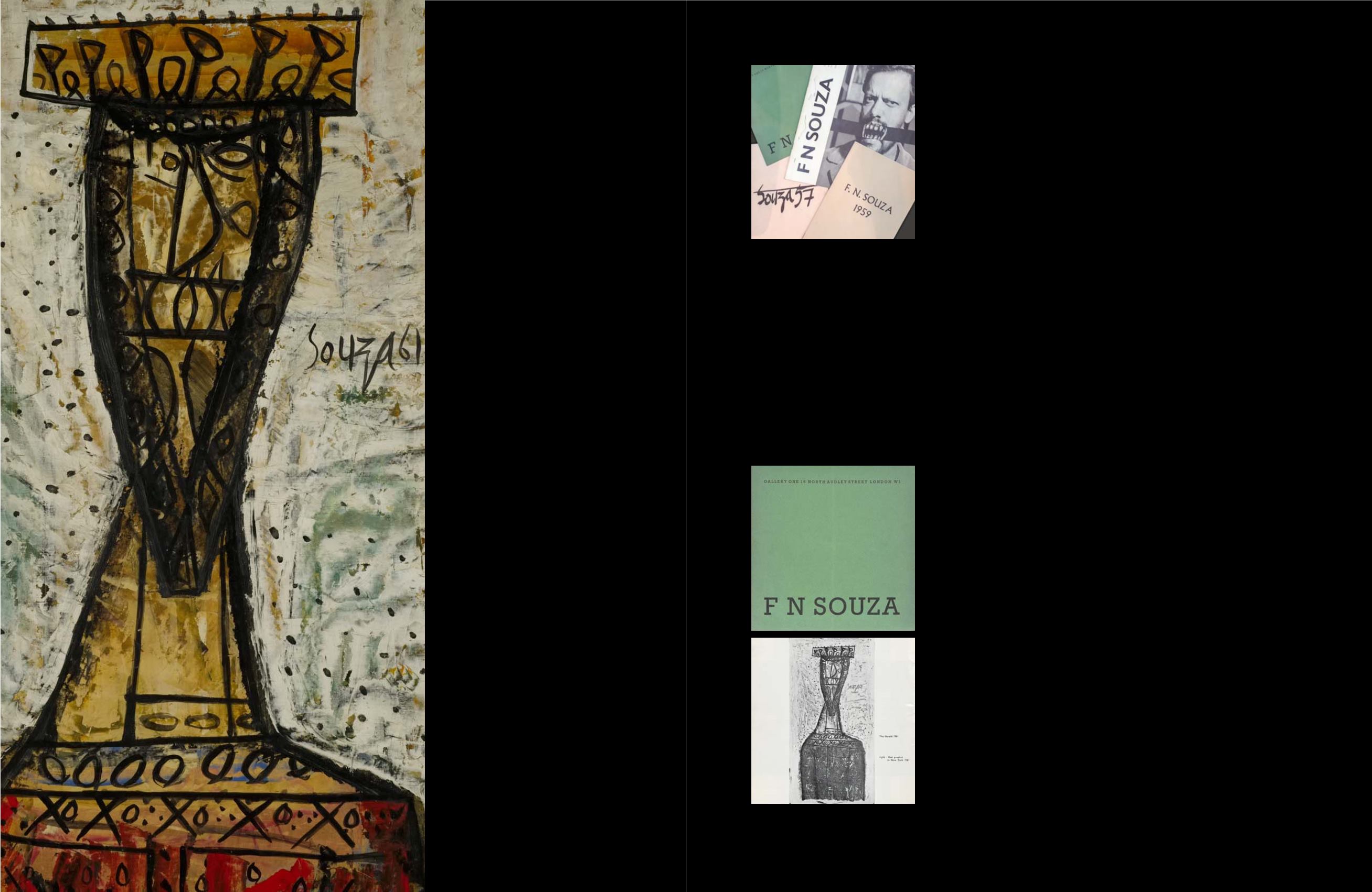

humanity. The grimacing face is sharp and angular, with
the gnashing teeth often seen in Souza’s portraits. The long
neck and rigid torso suggest an aura of royalty but also
discomfort. Similar works from the early 1960s have, “The
ability to capture both, the sorrow of emotional poverty
and the soulless grandeur of inherited power, [which] was a
remarkable feature of Souza’s imagery of royalty in a bygone
era.” (Aziz Kurtha,
Francis Newton Souza: Bridging Western
and Modern Indian Art
, Ahmedabad: Mapin Publishing,
2006, p. 85) Uneasy is the head that wears the crown in the
present lot. Painted with the confidence of an artist sure of
his craft,
The Herald
is a significant work from Souza’s finest
phase, combining clear imagery with stark emotion.
Gallery One played a significant role in Souza’s rise as an
artist. For nearly a decade, after his arrival in England, Souza
struggled to make ends meet. But following the publication
of his autobiography,
Nirvana of a Maggot,
in 1954, Souza
gained fame. The following year he met poet, art critic
and the owner of Gallery One, Victor Musgrave. Musgrave
and Souza’s interests coincided perfectly: Souza’s art was
iconoclastic, and Musgrave represented artists from outside
the establishment. In 1955, Musgrave organised Souza’s
first solo exhibition. The exhibition was a sell‒out and
proved to be a turning point for both Souza and Gallery
One. Subsequently, Musgrave held several successful shows
showcasing the artist’s work, which caught the attention of
leading critics. Souza’s solo exhibition in 1961, in which the
present lot was exhibited, included nineteen portraits and
landscapes, and was the “most impressive of all,” according
to his biographer, Edwin Mullins.
In the same year, George Butcher, a respected art critic,
wrote about Souza’s importance as an artist living in
London: “Behind Souza, on a rather profound level, stands
a continuous tradition, dramatically renewed since the
Independence of India, which has never been naturalistic or
abstract. Souza’s integrity to this tradition is also, surprisingly,
his strength in the context of Western painting.” (G M
Butcher, “The Image and Souza,”
The Studio
, Volume 162 No.
823, London: Longacre Press Pvt. Ltd., November 1961, p.
177) The period from the late 1950s through the 1960s was a
time when Souza had come into his own as an artist and was
able to consolidate influences from the East and the West to
create his own unique identity in the art world.
Catalogues of Souza’s solo exhibitions held in
1957, 1959, 1961 and 1962 at Gallery One
Cover of
F N Souza
, London: Gallery One, 1961
The present lot illustrated on p. 10
Dated 1961,
The Herald
comes
from what is widely considered
to have been the most prolific
and successful phase in F N
Souza’s career. He had moved to
England in 1949, and the freedom
of being on new shores led to a
time of great professional and
personal enrichment. The next
few decades were marked by work
that synthesised Souza’s learnings
from classical Indian and Western
art. His work till then already
drew from the splendour of the
architecture and ceremonies of
the Roman Catholic church, his
near brush with death from an
attack of small pox, the scenic
beauty of his native Goa, and the
poverty he witnessed in Bombay.
In England, he accessed an even
wider range of sources and
referenced literature, art, artists
and religions from many parts of
the world. In his own words, “It’s
all very well to talk in metaphors
about having one’s roots in one’s
own country. But roots need
water from clouds forming over
distant seas; and from rivers
having sources in different lands.”
The present lot is one of several
paintings from the early 1960s
when Souza painted figures and
heads of Catholic saints, kings,
and prophets. A herald was a
messenger in medieval times and
in Catholicism, is often an angel.
In this painting, the figure has no
markings of an angel and if he is
indeed, a messenger, “Hark the
herald,” as the hymn goes, as he
seems to bring news of Souza’s
own typically scathing views of
44
45


















